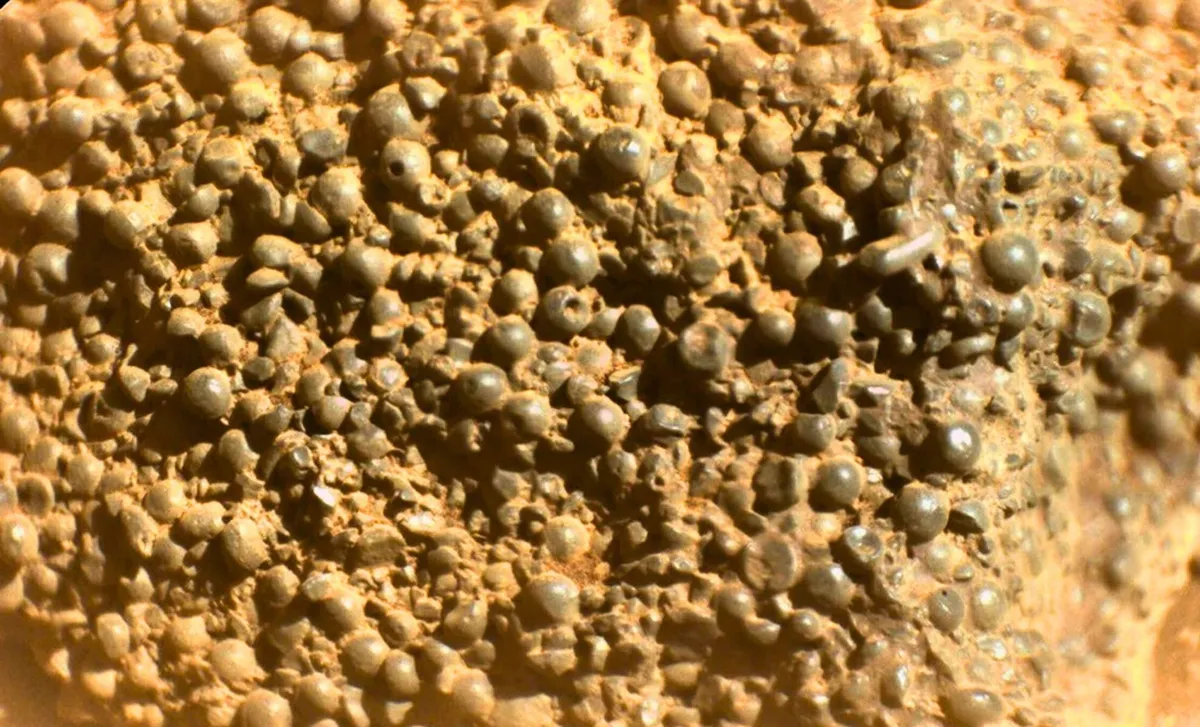
Earlier this month, NASA's Perseverance rover made an astounding discovery on the outer rim of Mars's Jezero Crater. The rover encountered a rock with an unusual appearance and structure that has left planetary scientists eager for answers. This intriguing rock, adorned with hundreds of dark gray spheres—some featuring tiny punctures—has ignited new inquiries about Mars's ancient surface processes, including water activity and potential violent volcanic or impact events.
The rock was identified on March 11, 2025, as Perseverance explored the lower slopes of Witch Hazel Hill, near an area known as Broom Point. While orbiters had previously detected light- and dark-toned bands in the region, the rover's discovery occurred while sampling a light-toned bedrock. Close to the sampling site, Perseverance noticed a peculiar loose rock that would soon be named St. Pauls Bay.
What makes this rock particularly intriguing is its texture: it contains hundreds of millimeter-sized dark gray spheres—some nearly perfect, others elongated or jagged, and a few punctured by tiny pinholes resembling miniature holes. NASA scientists immediately recognized the unusual morphology of this rock, especially given its geological context. Alex Jones, a PhD candidate at Imperial College London, posed a thought-provoking question in a blog post for NASA Science: “What quirk of geology could produce these strange shapes?” The presence of such detailed and variable spherules within a single loose rock raises both familiar and new questions about Mars's geological history.
This isn’t the first instance of similar structures being found on Mars. Back in 2004, the Opportunity rover discovered formations known as “Martian blueberries” in Meridiani Planum. Subsequently, Curiosity encountered spherules in the sedimentary rocks of Yellowknife Bay within Gale Crater. More recently, Perseverance identified popcorn-like spherules in the inlet channel of Jezero Crater, referred to as Neretva Vallis. In these earlier cases, formations were primarily interpreted as concretions—mineral nodules formed by groundwater percolating through rock over extended periods.
The team investigating St. Pauls Bay is currently exploring two distinct formation mechanisms for the spherules:
Groundwater Interaction: One theory suggests that the spherules are concretions formed when fluids circulating underground deposit minerals inside porous rocks. This process, which is common on Earth, often results in smooth, rounded shapes. If true for Mars, this would further substantiate the planet’s long-term hydrological activity.Volcanic or Impact Origin: Alternatively, the spherules might be volcanic droplets or impact melt fragments, created by the rapid cooling of molten rock during explosive events such as eruptions or meteorite impacts. These types of spherules typically exhibit jagged or broken forms similar to those observed in the St. Pauls Bay sample.Each hypothesis carries significantly different implications for understanding the evolution of Mars. As noted on the NASA blog, these spheres may originate from either sedimentary or igneous processes, making it crucial to differentiate between the two as part of ongoing scientific investigations.
One vital clue about the rock is that St. Pauls Bay is classified as a “float rock,” meaning it is not in its original location but has been transported or displaced. The Perseverance science team hypothesizes that it may have originated from one of the dark-toned strata visible from orbit on Witch Hazel Hill. If confirmed, this connection could link the unique texture of the rock to ancient geological layers yet to be sampled.
French geologist Gwenaël Caravaca, a member of both the Curiosity and Mars 2020 missions, emphasized the significance of this site, stating, “These terrains outside the crater are among the oldest ever explored on Mars—they date back to the Noachian, more than 3.7 billion years ago.” Since Perseverance is now venturing into terrain outside the main Jezero crater for the first time, this discovery may offer insights into Mars's primordial crust, which has remained untouched by the sedimentary processes observed within the crater.
Caravaca further explains that whether these formations are diagenetic concretions formed deep within rock through fluid interactions or volcanic/impact spherules, they likely predate the formation of Jezero Crater itself. This pushes their potential origins back to a time before rivers, lakes, or deltas shaped the Martian landscape.
NASA scientists are currently working to correlate the spherule-rich rock with specific geological layers in Witch Hazel Hill. Establishing such a link would aid in reconstructing the local stratigraphy and determine whether this feature is part of a broader layer shaped by water, fire, or something even more exotic. “Placing these features in geological context will be critical for understanding their origin,” NASA emphasizes. Achieving this goal would also refine our understanding of how different regions of Mars have evolved—not just the Jezero crater floor but the ancient terrain surrounding it.